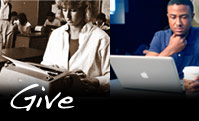Mentee finds job shadow visit with mentor 'inspiring and indispensable'

My Feb. 7 Art Institute of Chicago visit to shadow my mentor, Sarah Guernsey, Arts ’94 and the Deputy Director of Curatorial Affairs, came at a really crucial juncture in my career planning. My primary goal, of course, was to expand my understanding of alternate-academia careers—careers that would allow me to utilize my creative, analytical, research and writing skills outside the academy. Across my visit, I met with a range of museum professionals and sat in on a number of meetings. This behind-the-scenes glimpse into the workings of the Art Institute gave me an immersive and dynamic understanding of the different kinds of career opportunities that I might pursue in the future.
My visit came at the perfect time. I just started hearing back from some of the graduate programs to which I applied last semester. I had gotten two rejections and was thinking seriously about options I could pursue that didn’t involve a graduate degree. With this in mind, I was deliberate in my visit to ask questions that could inform my career decisions regardless of whether or not I earned the graduate degree I had planned.
During my job shadow, Sarah scheduled meetings with an array of people across the Art Institute in areas that interested me. I met with the Executive Director of Libraries and Archives; attended a meeting with Sarah and the Executive Director for Academic Engagement; met with the Executive Director of Publishing, the Editorial Director, and an Editor; joined a meeting with Sarah and the Director of Exhibitions; met with the Intellectual Property Manager from the Office of the General Counsel; and met with the Director of Interpretation from the Department of Learning and Public Engagement. My day was a mix of informational interviews and shadowing—seeing firsthand the workings of the Art Institute and the ways in which the people I met worked together, and seeing the sorts of intellectual and practical problems that were solved and grappled with on a daily basis. I learned an incredible amount, and saw first-hand the ways in which different departments work together and overlap, which involved an interdisciplinary collaboration that I found to be really exciting.
One of the meetings that stood out the most was my meeting with the Director of Interpretation, who is a part of the Department of Learning and Public Engagement. Coming into the meeting with no knowledge about what Interpretation entailed, I left it incredibly excited, as I discovered that her job involves a combination of broader level thinking about writing, genre, and audience that she tailors to different groups of museum patrons. This kind of thinking, of course—the intellectual combined with the educational—is enormously compelling for me, and was a career I had no knowledge of before my visit to see Sarah. Especially considering how relatively hidden careers like this are, it was incredibly exciting to consider the true breadth of my career prospects and find that jobs like this even existed. It was inspiring and heartening to find a group of people who were so passionate about their work and so committed to finding ways to engage publicly in this kind of upper-level thinking and appreciation of the arts and Humanities (work that is largely done in isolation in the academy).
During the visit, getting a specific sense of the dynamic range of people’s career pathways was also incredibly valuable for me. I’ve been able to find immense solace in considering the circuitous nature of the career paths of the people I met at the Art Institute, which gives me comfort as I pursue my own graduate degree and plan to pursue a career outside of academia. It was inspiring, too, to find the characteristics that united everyone I met: their stories were all shaped fundamentally by a passion for Humanities and the arts and a desire to bring it to the public—passions that paired with their desire to grapple with problems that required creative, analytical, and academic skill.
As a student considering pursuing an ‘alternate-academic’ career, this trip was a vital and indispensable learning experience. I not only got a sense of the work culture of museums more broadly—and the Art Institute specifically—but I had the chance to access and engage with an array of careers that remain largely hidden from the public eye. The breadth of careers for which Humanities degrees can prepare you is often a daunting prospect for me—especially considering that I plan to pursue it at the graduate level. With this in mind, my visit to shadow Sarah wasn’t only comforting, but it was inspiring and indispensable.
2018-19 MUAA Mentor Program Resource Guide
RESOURCES
December 2018 MUAA Mentor Program Newsletter
November 2018 MUAA Mentor Program Newsletter
For Mentors and Mentees
Preparing to be a good mentor, how reverse mentoring can benefit you and more
Responsibilities, tips, timely articles and more
50 Mentor and Mentee Questions
Relevant stories
3 reasons mentorship leads to winning for all involved
CNBC
6 things great mentors do differently
Entrepreneur
A
guide to job-hunting for graduates
Adecco
How to be
a good mentor
No Snivelling
What the best mentors do Harvard Business Review
13 habits of exceptionally likeable people
Forbes
Seven mentors you didn't even know you had
Entrepreneur
Why every entrepreneur needs a mentor
Forbes
It takes a mentor
New York Times
The modern mentor in a millennial workplace
Forbes
The unusual health and psychological benefits of being a mentor
Forum for Women Entrepreneurs
What my mentor taught me about being a mentor
Forbes
Pairing up with a younger mentor
The Wall Street Journal
Finding mentors in would-be bosses
The Almanac
Mentor methods: 7 ways to impact newbies
Upstart Business Journal





